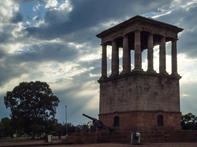The Big Hole in Kimberley
Kimberley is an interesting and worthwhile town to visit, but is also a great stopover en route to Cape Town and Johannesburg on the N2.

Kimberley houses a small airport, but the slightly busier airport is located in Bloemfontein, just 200 kilometres (120 miles) away along the N8. Guests on a South African holiday should visit Kimberley, well-known for the Big Hole. The Big Hole Centre houses various attractions related to the diamond mining rush in Kimberley in the late 19th and early 20th centuries. It is also the biggest man-made hole dug by hand in the world. Over 2 000 kgs of diamonds have been mined from the Big Hole, and today it stands 215 m deep filled with deep green algae-filled water. It’s deep colour contrasts against the dry landscape and makes for great photo opportunities.
The Big Hole Centre, The Kimberley Mine Museum and The Old Town can be found within proximity to one another, making this a fun-filled afternoon.The iconic Big Hole can also be viewed from a platform close to the Kimberley Mine Museum. Visitors are treated to an entertaining and informative film on the site and there is the opportunity to enter a re-created 19th century mine shaft. Situated adjacent to the Big Hole is The Old Town, a large open-air museum consisting of numerous original and reconstructed buildings, as well as other relics from the diamond-digging days, and provides a picture of life in early Kimberley. You can also view and purchase diamonds for a slightly lower price.
Kimberley Tram and McGregor Museum

A novel way of getting around is to take the Kimberley Tram, which runs between the City Hall and the museum. The restored 1914 tramcar is the only one of its kind still in Among the city's many architectural treasures are the City Hall, built in 1899 in Roman Corinthian style, De Beers House (the international headquarters of De Beers), and Dunluce. Dating back to 1897, the Edwardian-style Dunluce was elaborately decorated with ornate wooden decorations on the gables and wrought iron-work.
The several museums are worth exploring on a South African holiday, among them the McGregor Museum, built in 1897 by Rhodes. Dunluce (part of the McGregor Museum), Rudd House (a period museum portraying the life of the diamond magnates) and the Alexander McGregor Museum, with its extensive collection of rocks and minerals and displays on the archaeology of the Northern Cape. The William Humphreys Art Gallery houses a fine collection of South African art, while the Duggan-Cronin Gallery is an ethnographic museum with an invaluable collection of photographs chronicling the cultures of southern Africa's indigenous peoples.
Honoured Dead Memorial

The Honoured Dead Memorial is a reminder of the four-month siege of Kimberley during the South African War. The monument was commissioned by Cecil John Rhodes in memory of those who died during the siege and was designed by the renowned architect Sir Herbert Baker. Mounted on the stylobate of the monument is Long Cecil, a field gun manufactured in the De Beers workshops during the siege.
Kimberley was once home to two great South African political figures. The house where Sol Plaatjies, a founder member of the African National Congress and a distinguished journalist, lived in what was then known as the Malay Camp has been declared a national monument.
Also of historic interest is the house where Robert Sobukwe, founder and first President of the Pan Africanist Congress, lived following his release from political imprisonment on Robben Island. The town also plays host to a fascinating rock art site. These rock engravings depict a strange array of abstract shapes and designs. You can view the best of it at the Wildebeest Kuil Rock Art Centre. Kimberley has undergone serious upgrades, making this city a world-class destination. The town is more than the big hole, but also a part of South Africa’s history.